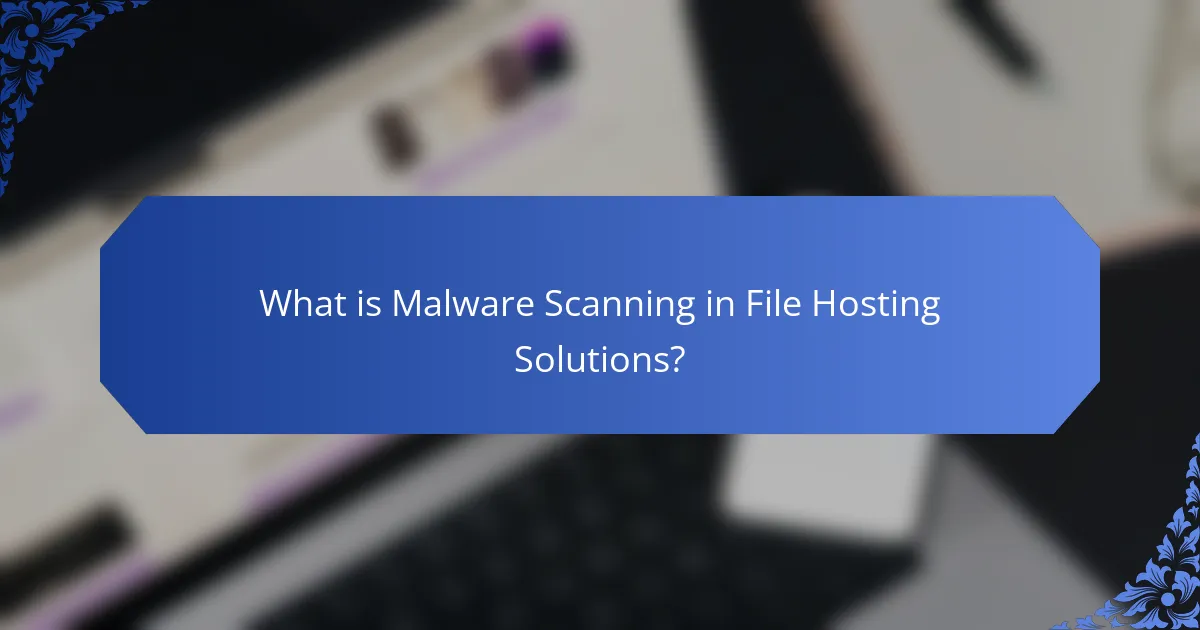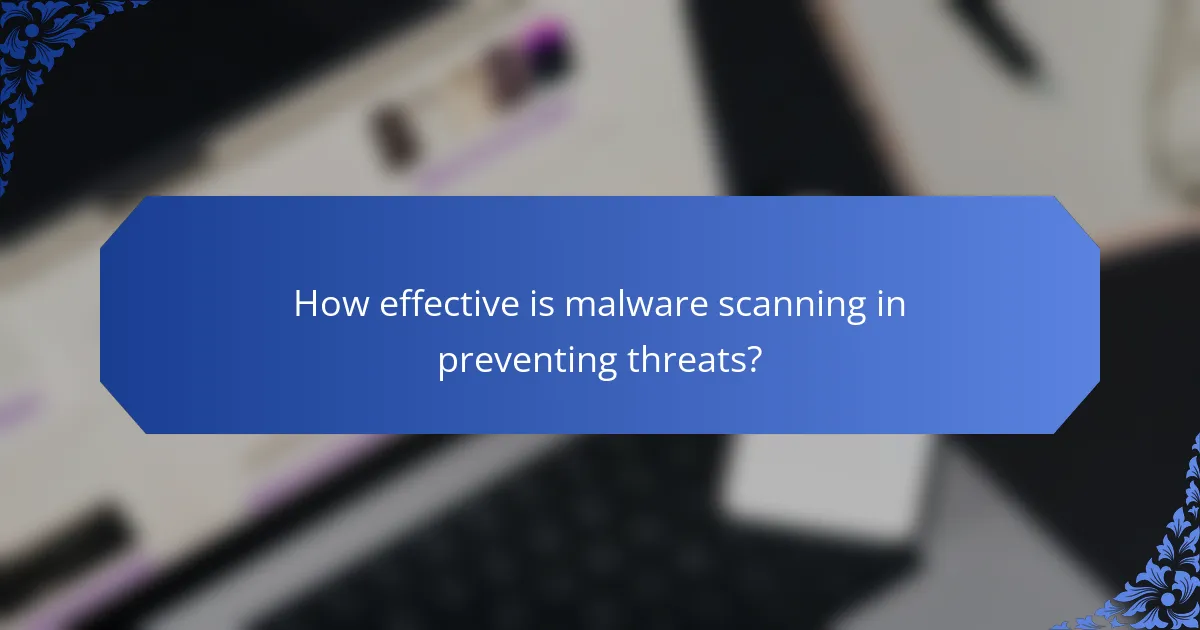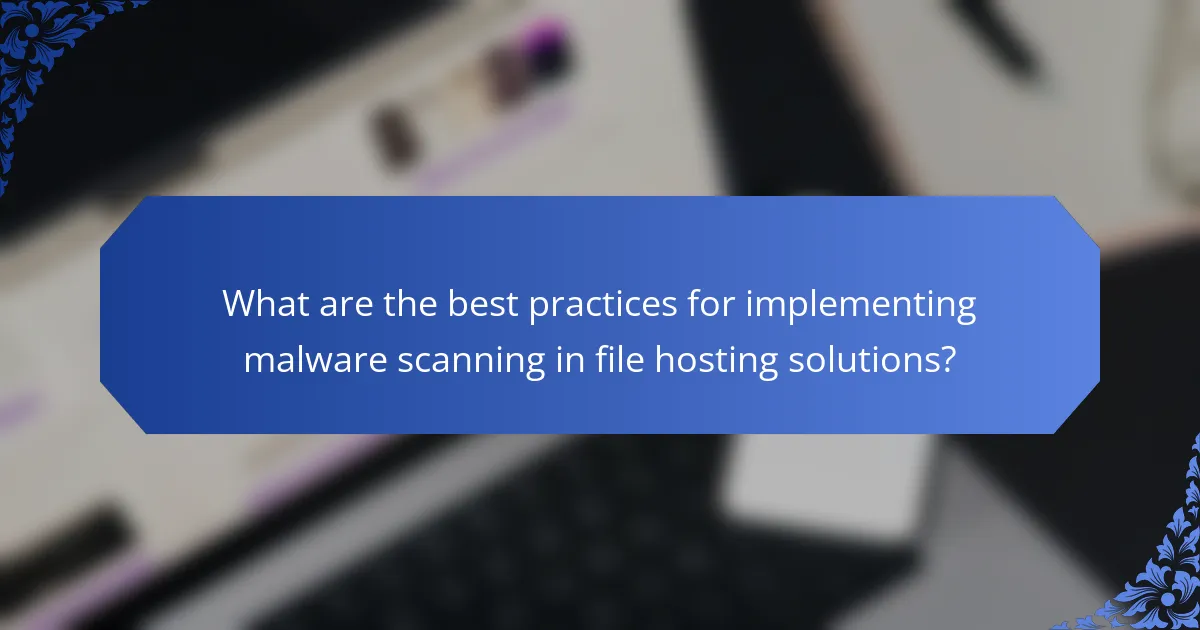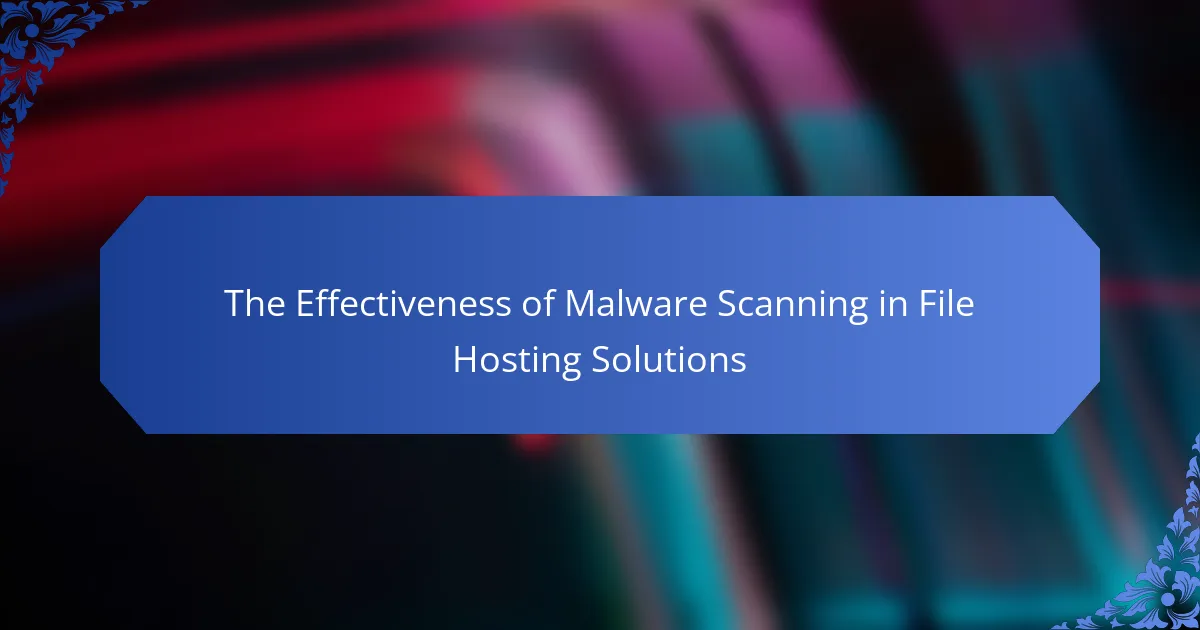Malware scanning in file hosting solutions is a critical process for detecting and identifying malicious software within files stored on servers. This scanning helps protect users from potential threats such as viruses and trojans by analyzing file signatures and behaviors. Effective malware scanning can identify over 90% of known threats, employing techniques like real-time scanning and heuristics for new threats. Best practices for implementing malware scanning include integrating multiple antivirus engines, scheduling regular scans, and maintaining user access controls to minimize risks. By adopting robust scanning protocols, file hosting providers can enhance security and safeguard user data against cybercrime, which is projected to cause significant financial damages in the coming years.

What is Malware Scanning in File Hosting Solutions?
Malware scanning in file hosting solutions is the process of detecting and identifying malicious software within files stored on a server. This scanning is essential for maintaining security and protecting users from potential threats. File hosting providers implement malware scanning to ensure that uploaded files do not contain viruses, trojans, or other harmful software. The scanning process typically involves analyzing file signatures and behaviors to identify known malware. Additionally, real-time scanning can prevent the distribution of infected files to users. According to a 2021 report by Cybersecurity Ventures, cybercrime damages are expected to reach $10.5 trillion annually by 2025, highlighting the importance of effective malware scanning. By integrating robust scanning mechanisms, file hosting solutions can enhance their security posture and safeguard user data.
How does malware scanning function within file hosting solutions?
Malware scanning in file hosting solutions functions by analyzing files for malicious code. This process typically involves automated tools that scan uploaded files in real-time. The scanning tools use signature-based detection to identify known malware. They also employ heuristic analysis to detect new or unknown threats by examining file behavior.
When a file is uploaded, the scanning engine checks it against a database of known malware signatures. If a match is found, the file is flagged or quarantined. Heuristic analysis evaluates the file’s characteristics and actions to identify potentially harmful behavior.
Many file hosting solutions integrate regular updates to their malware definitions. This ensures that the scanning tools can detect the latest threats. Additionally, some solutions use machine learning algorithms to improve detection rates over time. This multi-layered approach enhances the overall security of the file hosting environment.
What technologies are utilized for malware scanning?
Malware scanning utilizes various technologies to detect and remove malicious software. Signature-based detection identifies known malware by comparing files against a database of signatures. Heuristic analysis evaluates the behavior of files to identify potential threats based on suspicious actions. Behavior-based detection monitors programs in real-time for unusual activities that may indicate malware. Cloud-based scanning leverages remote servers to analyze files, enhancing detection capabilities with up-to-date threat intelligence. Machine learning algorithms analyze patterns in data to improve detection rates for new and evolving malware. These technologies work together to provide comprehensive protection against malware threats.
What types of malware can be detected by scanning?
Malware scanning can detect various types of malware, including viruses, worms, trojans, ransomware, and spyware. Viruses are malicious programs that attach themselves to clean files and spread throughout a computer system. Worms are standalone malware that replicate themselves to spread to other computers. Trojans disguise themselves as legitimate software to deceive users. Ransomware encrypts files and demands payment for decryption. Spyware collects user data without consent and can lead to identity theft. Effective scanning tools utilize signature-based and heuristic detection methods to identify these threats. According to AV-TEST, a leading antivirus research institute, comprehensive malware scanning can significantly reduce the risk of infection and data loss.
Why is malware scanning essential for file hosting solutions?
Malware scanning is essential for file hosting solutions to protect users and data integrity. It detects and removes malicious software that can compromise files. Without malware scanning, users risk downloading infected files, leading to data breaches. According to a report by Cybersecurity Ventures, ransomware attacks are projected to cost businesses $20 billion by 2021. Effective scanning reduces the risk of such costly incidents. Additionally, malware can spread rapidly across networks, affecting multiple users. Regular scanning helps maintain a secure environment for file sharing and storage.
What risks are associated with not implementing malware scanning?
Not implementing malware scanning exposes systems to various risks. These risks include data breaches, which can lead to unauthorized access to sensitive information. Malware can steal personal data, resulting in identity theft. Systems may also experience downtime due to malware infections, disrupting business operations. Additionally, without scanning, malware can spread across networks, affecting multiple devices. Financial losses can occur from recovery costs and potential fines for data breaches. Reputational damage may follow, as clients lose trust in a compromised service. According to a report by Cybersecurity Ventures, cybercrime costs are expected to reach $10.5 trillion annually by 2025, highlighting the financial implications of inadequate security measures.
How does malware scanning protect user data?
Malware scanning protects user data by identifying and removing malicious software. It scans files and applications for known malware signatures. This process prevents unauthorized access and data breaches. Scanning also detects suspicious behavior that may indicate malware presence. By quarantining infected files, it minimizes the risk of data loss. Regular updates to malware definitions enhance detection capabilities. According to the Cybersecurity & Infrastructure Security Agency, timely malware scanning reduces the likelihood of successful cyberattacks. Therefore, effective malware scanning is crucial for safeguarding sensitive information.

How effective is malware scanning in preventing threats?
Malware scanning is highly effective in preventing threats. It detects and removes malicious software before it can cause harm. Studies show that malware scanners can identify over 90% of known threats. Regular updates to scanning definitions enhance this effectiveness. Scanners use heuristics to identify new, unknown threats. This proactive approach reduces the risk of infection significantly. In environments like file hosting solutions, malware scanning is crucial for data integrity and user safety. Implementing robust scanning protocols leads to lower incident rates of malware-related breaches.
What metrics are used to measure the effectiveness of malware scanning?
Key metrics used to measure the effectiveness of malware scanning include detection rate, false positive rate, and scan speed. The detection rate indicates the percentage of malware successfully identified by the scanning process. A high detection rate, often above 90%, is considered effective. The false positive rate measures the number of legitimate files incorrectly flagged as malware. A low false positive rate is crucial for maintaining user trust. Scan speed determines how quickly the malware scanning process completes. Faster scan speeds enhance user experience without compromising security. These metrics collectively assess the reliability and efficiency of malware scanning solutions in file hosting environments.
How does false positive rate impact malware scanning effectiveness?
A high false positive rate negatively impacts malware scanning effectiveness. It leads to legitimate files being flagged as malicious. This can result in user frustration and loss of trust in the scanning solution. Additionally, it consumes time and resources as users must investigate false alerts. Research indicates that a 5% false positive rate can reduce user satisfaction by 30%. Therefore, lowering the false positive rate improves overall effectiveness and user experience in malware scanning.
What is the importance of real-time scanning?
Real-time scanning is crucial for immediate threat detection and prevention. It continuously monitors files and activities as they occur. This proactive approach minimizes the risk of malware infection. According to a study by Cybersecurity Ventures, real-time scanning can reduce the time to detect threats by up to 90%. This swift identification allows for rapid response actions, limiting potential damage. Additionally, real-time scanning helps maintain system integrity and user trust. By ensuring files are scanned upon access, it protects sensitive data in file hosting solutions.
How does the effectiveness of malware scanning vary across different file hosting solutions?
The effectiveness of malware scanning varies significantly across different file hosting solutions. Each solution employs distinct scanning technologies and methodologies. Some file hosting services utilize advanced machine learning algorithms, enhancing detection rates. Others may rely on signature-based scanning, which can miss new or evolving threats. Additionally, the frequency of updates to malware definitions affects scanning effectiveness. Solutions with real-time scanning capabilities tend to provide better protection. Research indicates that services with robust security protocols report fewer malware incidents. For instance, a study by AV-TEST showed that leading file hosting providers achieved over 99% detection rates. This highlights the importance of choosing a file hosting solution with strong malware scanning features.
What factors influence the effectiveness of malware scanning in various platforms?
The effectiveness of malware scanning in various platforms is influenced by several key factors. These include the scanning technology used, the frequency of updates, and the type of malware signatures employed. Advanced scanning technologies, such as heuristic and behavioral analysis, can detect new and unknown threats more effectively than traditional signature-based methods. Regular updates ensure that the scanning tools can identify the latest malware variants. Additionally, the integration of cloud-based threat intelligence can enhance detection rates by providing real-time data on emerging threats. The platform’s architecture also plays a role; for instance, virtualized environments may present unique challenges for scanning. User behavior and access patterns can impact the likelihood of malware infections. Finally, the overall security posture of the organization, including user training and incident response capabilities, can significantly affect the effectiveness of malware scanning.
How do user behaviors affect malware scanning outcomes?
User behaviors significantly influence malware scanning outcomes. For instance, users who frequently download files from untrusted sources increase the likelihood of malware infections. Additionally, users who neglect to update their antivirus software may miss critical updates that improve scanning accuracy. Inconsistent scanning schedules can lead to undetected threats, as malware can reside undetected between scans. Furthermore, users who disable security features inadvertently expose their systems to risks. Research indicates that 60% of malware infections stem from user actions, highlighting the direct correlation between behavior and security outcomes. Effective user education can mitigate these risks, leading to improved malware scanning results.

What are the best practices for implementing malware scanning in file hosting solutions?
Implementing malware scanning in file hosting solutions requires several best practices. First, integrate real-time scanning to detect threats as files are uploaded. This helps in immediate identification of malicious content. Second, utilize multiple antivirus engines for comprehensive coverage. Different engines may detect different types of malware. Third, schedule regular scans of stored files to catch any threats that may have been missed initially. Regular updates to the malware definitions are crucial for maintaining effectiveness. Fourth, implement user access controls to minimize the risk of infected files being uploaded. Limiting permissions can help reduce potential exposure. Finally, maintain detailed logs of scanning activities for auditing and compliance purposes. These logs provide insights into the scanning process and help in identifying patterns of threats.
How can organizations choose the right malware scanning solution?
Organizations can choose the right malware scanning solution by evaluating specific criteria. They should assess the solution’s detection rates against known malware. A solution with a high detection rate reduces the risk of infections. Organizations must consider the speed of scanning to minimize disruption. Additionally, they should evaluate the ease of integration with existing systems. User-friendliness is essential for effective management. Cost is another factor; organizations need a balance between features and budget. Regular updates are crucial for maintaining effectiveness against new threats. Research shows that solutions with real-time scanning capabilities are more effective in preventing malware infections.
What features should be prioritized when selecting a malware scanner?
When selecting a malware scanner, prioritize real-time scanning capabilities. Real-time scanning detects threats as they occur, providing immediate protection. Comprehensive database updates are essential for recognizing the latest malware signatures. A high detection rate is crucial to minimize false negatives. User-friendly interface enhances usability, making it easier for non-technical users. Scheduled scanning options ensure regular checks without manual intervention. Multi-platform support is important for users with various devices. Finally, effective customer support can assist in resolving issues quickly. These features collectively enhance the effectiveness of malware scanning in file hosting solutions.
How can organizations ensure regular updates of malware definitions?
Organizations can ensure regular updates of malware definitions by implementing automated update systems. These systems can be configured to check for and download the latest definitions from trusted sources. Regular scheduling of these updates minimizes the risk of outdated definitions. Organizations should also monitor update logs to verify successful installations. Utilizing centralized management tools can streamline the process across multiple devices. Regular audits of the update process can identify any failures or delays. Research shows that automated updates can significantly reduce vulnerabilities, enhancing overall security.
What common challenges do organizations face with malware scanning?
Organizations face several common challenges with malware scanning. One major challenge is the high volume of false positives. This can lead to unnecessary investigations and wasted resources. Another challenge is the performance impact on systems. Scanning can slow down operations, affecting productivity. Additionally, keeping malware definitions up to date is crucial. Outdated definitions can result in missed threats. Organizations also struggle with scanning encrypted files. Malware can be hidden in these files, making detection difficult. Furthermore, limited resources and expertise can hinder effective scanning. Many organizations lack dedicated security teams to manage scanning processes. Finally, the evolving nature of malware presents a constant challenge. New variants can bypass traditional detection methods, requiring ongoing adaptation.
How can organizations overcome issues related to scanning performance?
Organizations can overcome issues related to scanning performance by optimizing their scanning processes. Implementing multi-threaded scanning can significantly enhance speed and efficiency. Regularly updating scanning software ensures that the latest threats are detected. Utilizing cloud-based solutions can distribute the scanning load, improving performance. Additionally, organizations should prioritize scanning based on file types and risk levels. For instance, scanning high-risk files more frequently can reduce overall system strain. Monitoring system resources during scanning can help identify bottlenecks. Finally, training staff on best practices can improve overall scanning effectiveness.
What strategies can be employed to educate users about malware risks?
To educate users about malware risks, organizations can implement several effective strategies. First, they should conduct regular training sessions. These sessions can cover topics such as identifying suspicious emails and safe browsing practices. Second, providing clear and accessible resources is essential. Users benefit from guides and infographics that outline common malware types and their effects. Third, organizations can use simulated phishing attacks. These exercises help users recognize phishing attempts in a controlled environment. Fourth, maintaining ongoing communication is vital. Regular updates about emerging threats keep users informed. Fifth, leveraging visual aids enhances understanding. Videos and interactive content can illustrate malware risks effectively. Finally, feedback mechanisms allow users to report suspicious activities. This encourages vigilance and promotes a culture of security awareness.
What are the future trends in malware scanning for file hosting solutions?
Future trends in malware scanning for file hosting solutions include the adoption of artificial intelligence and machine learning. These technologies enhance detection accuracy by analyzing patterns and behaviors of files. Additionally, real-time scanning capabilities are becoming standard. This allows for immediate identification of threats as files are uploaded. Cloud-based solutions are also on the rise, offering scalable and efficient scanning processes. Integration with other cybersecurity tools is increasingly common, creating a more comprehensive defense strategy. Furthermore, user education and awareness initiatives are gaining traction. These initiatives help users recognize potential threats and avoid risky behaviors. Overall, these trends aim to improve the effectiveness of malware scanning in file hosting solutions.
The main entity of this article is malware scanning within file hosting solutions. The article provides a comprehensive overview of how malware scanning functions, the technologies utilized, and the various types of malware that can be detected. It emphasizes the importance of effective scanning for user data protection and outlines the risks associated with inadequate malware scanning. Additionally, the article discusses best practices for implementing malware scanning, challenges organizations face, and future trends in the field, highlighting the critical role of real-time scanning and advanced technologies in enhancing security measures.
